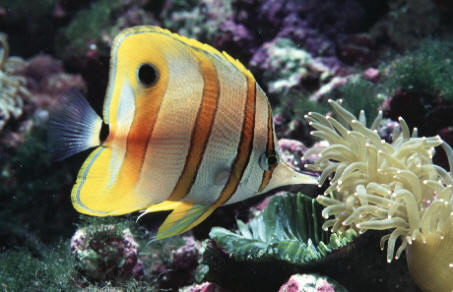| How big are they? (Maximum length)
What do they look like? (Appearance)
- Thin, disc-like body
- Four copper-colored bars on a white body
- Protruding mouth
- Large eyespot above tail
- Body shape allows the butterflyfish to move among
the rocks on a coral reef and find food in the nooks and crannies there.
- The large eyespot above its tail and the band
through the real eye confuse enemies.
What do they eat? (Diet) Omnivorous
- Picks particles of food from between coral
heads with its long snout
- Likes krill, small shrimp, mussels, and clams
- Prefers live food like brine shrimp.
- Eats coral polyps
- Needs plants such as algae.
What eats them? Sharks and eels
Reproduction:
-
Many butterflyfishes are found in pairs.
-
Larva drift with
plankton for 2-3 months before changing into juvenile butterflyfishes.
How long do they live? ?
Classification:
|
Where do they live? (Environment, Habitat, Range)
-
Indo-Pacific Oceans, Found in:
-
East Africa in the Indian Ocean
-
Japan
-
Philippines
-
Australia
-
New Caledonia in the Pacific Ocean.
- Found near rocky shores and coral reefs

How deep in the ocean are they found?
(Zone)
Characteristics
- Found singly or in pairs
- These are shy butterflyfish, but
can be
- Highly territorial and
aggressive
- Will sometimes
injure other fish – particularly their own kind – if they come too
close.
- Favored for saltwater aquaria.
What is their Endangerment Status?
- Considered unthreatened, but read below:
- Harvesting
of butterflyfishes from the wild may involve the use of cyanide or
blasting which damages the habitat and kill many other creatures.
- Like other fish and creatures
harvested from the wild, most die before they can reach the stores.
- Without professional care, most die
soon after they are sold. Often they die of starvation because owners are unable to
provide the animals and plants that these fishes need to
survive.
- Those that do survive are unlikely to
breed.
|


 /
/